The Evolution and Impact of First-Person Shooter Games
Last updated:
I’ve seen how first-person shooter (FPS) games changed gaming for good. FPS games let you see the world through the player’s eyes, making the experience feel very real and immersive. They started with simple graphics but pushed gaming technology forward, moving from blocky shapes to photorealistic environments you can almost step into.
Over time, FPS games got better with faster game development and smarter designs. This helped them shape the gaming industry by setting new standards for how games look and feel. They also played a big part in growing competitive gaming. Thanks to FPS games, eSports and online multiplayer became huge, connecting players worldwide.
Another cool thing is how storytelling in FPS games got stronger. It’s not just about shooting anymore; good stories now pull players in and make the game world feel alive. All this shows why FPS games hold a special place in gaming history and keep pushing the industry ahead.
Want to know how screen resolution can impact your FPS gaming experience and possibly cause hardware slowdowns? Check out our guide on how resolution causes bottlenecks for everything you need to keep your system running smoothly in the most demanding shooters.
Counter-Strike: From Half-Life Mod to Competitive FPS Legend
I’ve seen how Counter-Strike started as just a simple mod for Half-Life back in 1999. Minh “Gooseman” Le and Jess Cliffe made it for fun, but it quickly caught fire. Valve noticed and turned it into a full game that changed competitive FPS forever.
The game is all about teams—terrorists versus counter-terrorists—with clear goals to complete. What really made it stand out was the round-based play where players earn money each round to buy better weapons. This economy system added a new layer of strategy that many other tactical shooters later copied.
Counter-Strike’s rise kicked off the esports scene big time. It became a staple in tournaments worldwide, with pro leagues forming around it. Versions like CS 1.6, Source, and especially CS:GO kept the game fresh. Today, CS:GO still pulls over a million players online at once and the whole franchise has sold more than 25 million copies.
Honestly, Counter-Strike set the blueprint for modern team-based competitive FPS games. It’s tactical, fast, and still relevant after all these years—showing why it’s a true legend in gaming history.
Halo: How It Changed Console FPS Forever
I’ve seen how Halo showed the world that FPS games could really work on consoles. When Bungie released Halo: Combat Evolved in 2001 as an Xbox launch title, it changed everything about playing shooters on a gamepad.
Halo’s controls were made just right for consoles, making FPS easy and fun without a mouse and keyboard. The game also brought vehicles into combat, which shook up the usual run-and-gun style and added new tactics. Another big deal was the regenerating health shield—it let players recover without always needing health packs, something that became a standard for many games after.
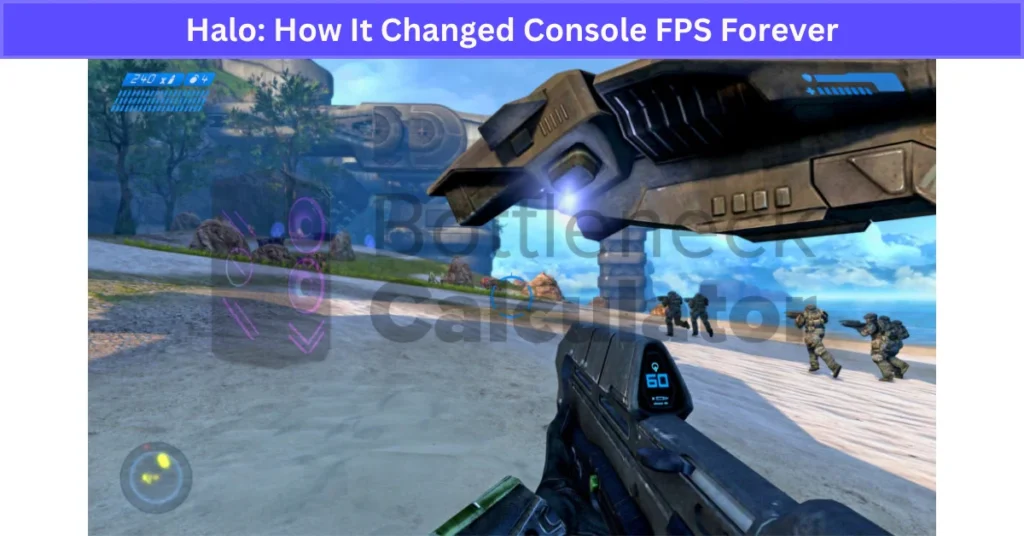
Before Xbox Live, Halo made LAN parties a huge thing, with friends gathering to play together in the same room. Later, online multiplayer helped it grow into a major competitive FPS for consoles. Beyond gameplay, the sci-fi world and Master Chief became iconic, shaping gaming culture and inspiring many other franchises like Destiny and Call of Duty.
Halo sold over 5 million copies by 2005 and played a big part in making Xbox a success. It’s safe to say Halo set the blueprint for how console shooters work and still influences games today.
Doom (1993) – The FPS Game That Redefined Gaming
I’ve seen people call Doom one of the most important games ever, and for good reason. Released by id Software in 1993, Doom changed how we think about FPS games and gaming as a whole.
Doom was fast and intense, with action that kept players on their toes. It introduced new mechanics like the deathmatch multiplayer mode, which basically kicked off competitive gaming as we know it. Everyone wanted to battle friends online or over LAN, making it a social and thrilling experience. The weapons, especially the BFG-9000, became icons in gaming culture—people still talk about that massive gun today.
Technically, Doom used a clever pseudo-3D engine that made levels feel more real and immersive than its predecessor, Wolfenstein 3D. This leap helped set the stage for more complex game worlds and smooth controls, which Doom also helped standardize. The game’s influence went beyond just playing; it sparked one of the biggest modding communities ever. Players made custom maps, new monsters, and even total game changes, keeping Doom alive for years.
Between 15 and 20 million people downloaded Doom within two years—pretty crazy for the early ’90s! It’s clear Doom wasn’t just a game; it was a movement. Its legacy lives on in every competitive FPS and multiplayer shooter you see today.
Wolfenstein 3D (1992) – The Game That Started It All
I’ve seen Wolfenstein 3D called the grandfather of FPS games for a good reason. Made by id Software in 1992, it laid the groundwork for what first-person shooters would become.
The game put players in the shoes of Allied spy B.J. Blazkowicz, sneaking through a Nazi castle full of maze-like corridors. What made it stand out was its first-person view, which felt fresh and exciting back then. It also brought in texture-mapped walls and digital sound effects, making the experience much more immersive for players at the time.
Wolfenstein 3D introduced the core parts of FPS gameplay: running, shooting, and exploring levels from the player’s perspective. It showed that fast-paced action with a personal view could really work as a game style. This success helped prove that FPS games could be popular and fun, inspiring hits like Doom soon after.

The game was a hit, selling over 200,000 copies in its first year, and won awards for Most Innovative Game and Best Action Game in 1992. Its impact still echoes today because it set the basic rules for how FPS games play and feel. If you think about it, without Wolfenstein 3D, the FPS genre might look very different now.
Quake (1996) – The First True 3D FPS That Changed Gaming
I’ve seen Quake called a milestone, and it’s easy to see why. Released in 1996 by id Software, Quake was the first fully 3D FPS, moving beyond the flat, sprite-based graphics of earlier games. It used real 3D models and environments, letting players look and move in all directions, which made gameplay feel way more immersive.
Quake set new standards for FPS games by combining this technical leap with fast, smooth action. It also helped launch multiplayer FPS as a serious thing, laying the foundation for esports with its competitive matches and strong community. Its improved network code made online play much more reliable, which was a big deal back then.
The Quake engine was so powerful that many other games licensed it, influencing titles like Half-Life and Call of Duty later on. Plus, its modding community was massive—players created tons of custom maps and game modes, keeping Quake fresh and alive for years.
Honestly, Quake shook up a market that had felt stuck and showed how much FPS games could grow. Its legacy still lives on in nearly every modern shooter you play today.
Far Cry (2004) – The FPS That Brought Big Open Worlds
I’ve seen Far Cry change how shooters were made, and it really broke the mold. Released in 2004 by Crytek, Far Cry was one of the first FPS games to offer huge open-world levels instead of the usual narrow, corridor-style maps.
The game gave players freedom like never before. You could sneak around using stealth or go in guns blazing. The enemies weren’t just dumb targets—they used the terrain to hide, flank, and surprise you, making the fights feel smarter and more tactical.
Far Cry also pushed gaming technology forward with its CryEngine. The tropical island looked stunning with realistic lighting, detailed environments, and long draw distances that felt fresh back then. It was a big leap from most shooters of its time.
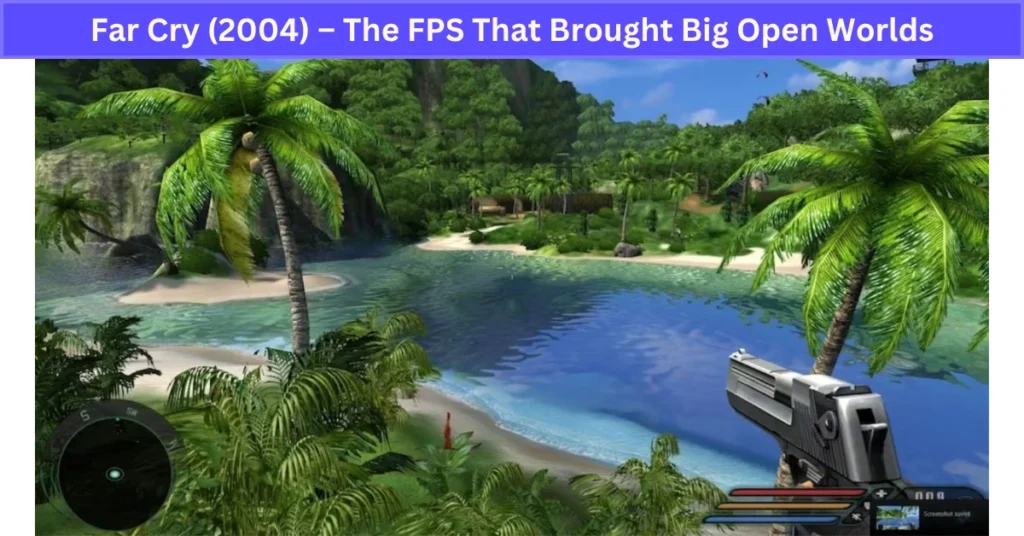
This game laid the ground for many open-world FPS titles that came later, including the sequels in its own series and games like Crysis. Far Cry sold over 730,000 copies in its first four months, proving that players loved this new style.
Far Cry changed the way we think about shooter maps, tactics, and visuals—and its influence is still clear in today’s big FPS games.
Doom 3 (2004) – Reinventing Doom with Horror and Tech
I’ve seen Doom 3 take a big risk by changing the classic fast-paced Doom into something darker and scarier. Released in 2004 by id Software, it rebooted the Doom franchise by mixing survival horror with modern FPS gameplay.
Doom 3 used the advanced id Tech 4 engine to create real-time lighting and dynamic shadows. This made the game’s dark, creepy environments much more immersive. Instead of rushing through levels, players had to manage limited ammo and carefully use their flashlight, which added real tension. The slower pacing and jump scares gave Doom 3 a strong horror feel, different from the old Doom games.
The story also got more attention, with cinematic cutscenes blending into gameplay to pull players deeper into the experience. It was one of the first big FPS games to show off realistic lighting and physics on PC, pushing technical limits for the time.
Doom 3 sold over 3.5 million copies worldwide, becoming a huge success. Its blend of horror and FPS inspired other games like FEAR and influenced later Doom reboots. Even though some fans missed the fast action, Doom 3 proved FPS games could nail atmosphere and graphics in new ways, setting a high bar for horror shooters.
GoldenEye 007 (1997) – The Console FPS Game-Changer
I’ve seen GoldenEye 007 called a legend, and honestly, it earned that spot. Released for the Nintendo 64 in 1997, GoldenEye 007 showed the world that FPS games could actually work—and be a blast—on consoles.
Before GoldenEye, first-person shooters were mostly stuck on PCs. This game changed all that by making smooth FPS gameplay possible with just an N64 controller. The controls were super smart for their time, letting players aim, move, and shoot with surprising ease. It set the standard for how console FPS controls should feel—Halo and so many others followed this path.
One of the coolest things was the split-screen multiplayer mode. I remember playing with friends for hours, battling it out in the same room. It turned gaming into a big social event and basically started the living room multiplayer craze. No online connection needed—just four controllers and a bunch of snacks.
GoldenEye’s missions were built with real thought, too. They weren’t just “run here, shoot that”—each level had its own objectives, and the harder the difficulty, the more you had to do. This gave the game major replay value and kept things feeling fresh.
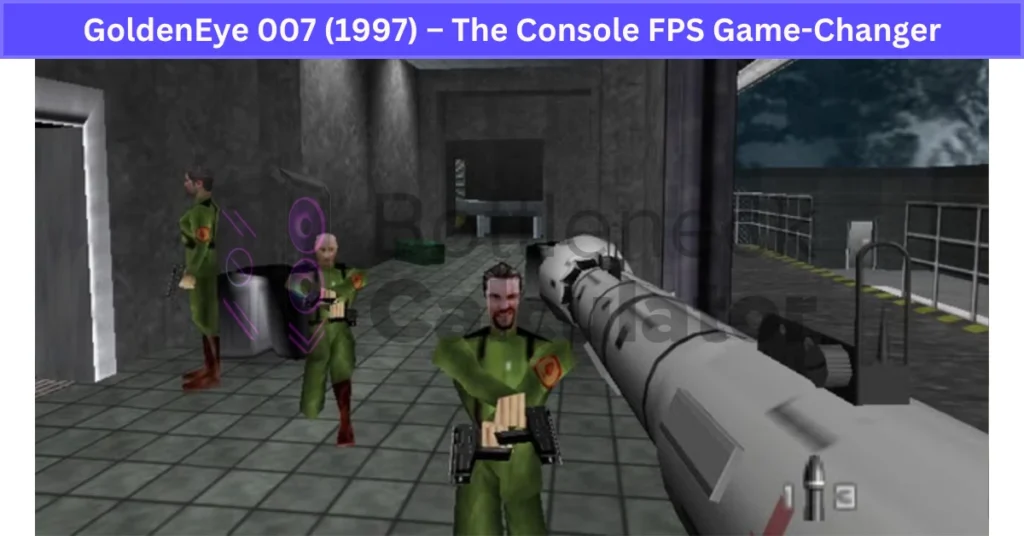
It nailed the little details, like the classic James Bond death animation and all those bits pulled straight from the movie. Everything felt true to the Bond world, from the weapons to the locations. That attention to detail made it stand out.
GoldenEye 007 went on to sell over 8 million copies worldwide, making it one of the best-selling and most influential N64 games ever. Its legacy is huge—it proved consoles could handle FPS games, inspired future hits like Halo, and turned split-screen multiplayer into a must-have. Even now, GoldenEye is a timeless classic that changed console FPS history for good.
Half-Life (1998) – The Story-Driven FPS Revolution
I’ve seen a lot of games try to tell good stories, but Half-Life set a new bar that still holds up today. When Valve released Half-Life in 1998, it didn’t just give players another shooter—it totally changed how FPS games could feel and what they could do.
What made Half-Life 1998 innovations stand out was how the story was delivered. Instead of cutting away to movie-like scenes, everything happened around you in real time. You played as Gordon Freeman, just a regular scientist at the Black Mesa facility, thrown into chaos after an experiment goes wrong. But you never lose control—there’s no “sit and watch” moment. The story just… happens, right in the middle of the action. It pulled me in like no other game before.
The game’s AI was another big deal. Enemies weren’t just running straight at you; they’d take cover, work together, and even try to flank you. It felt like fighting real opponents, and it made every battle tense and unpredictable. That FPS AI evolution became the new goal for other shooters.
Half-Life didn’t just nail story and smart enemies—it also brought in environmental storytelling in games and cool physics-based puzzles. You had to think about how to move crates, open doors, or use machines to solve problems. It wasn’t just about shooting your way out. This mix of action and clever thinking made the game stand out.
People took notice—Half-Life grabbed more than 50 Game of the Year awards and is still called one of the greatest games ever made. It sold over 9 million copies and sparked one of the strongest modding communities in history. Fun fact: Counter-Strike, one of the most famous competitive shooters, actually started as a mod for Half-Life.
Half-Life inspired so many games that came after. Its way of telling a story, blending it right into gameplay, and making players part of the world set a new standard. It’s the reason modern FPS games feel alive, not just like simple shooting galleries. I’d say it’s one of those rare games that changed everything for the better.
Unreal (1998) – A Visual Revolution and Engine Legacy
I’ve seen Unreal 1998 called a game-changer, and honestly, it’s true. When Unreal dropped in 1998, made by Epic MegaGames and Digital Extremes, it blew people away with how a first-person shooter could look and feel. Back then, no one had seen graphics like this in an FPS—the lighting, water effects, and super-detailed textures just looked next-level.
The story drops you in as a prisoner who crash-lands on the alien planet Na Pali. Instead of just blasting through tight hallways, you wander around these huge, open, colorful spaces. There’s action, sure, but also tons of exploring. The world feels strange and alive, pulling you in way deeper than most shooters from that era.
What really set Unreal apart was the debut of the Unreal Engine. For the first time, developers could build games with realistic lighting and water, plus effects we’d never seen before. This tech wasn’t just good for one game—it ended up powering hundreds of titles, all the way up to Unreal Engine 5 today. It’s wild to think that what started with Unreal is now behind some of the world’s biggest games.
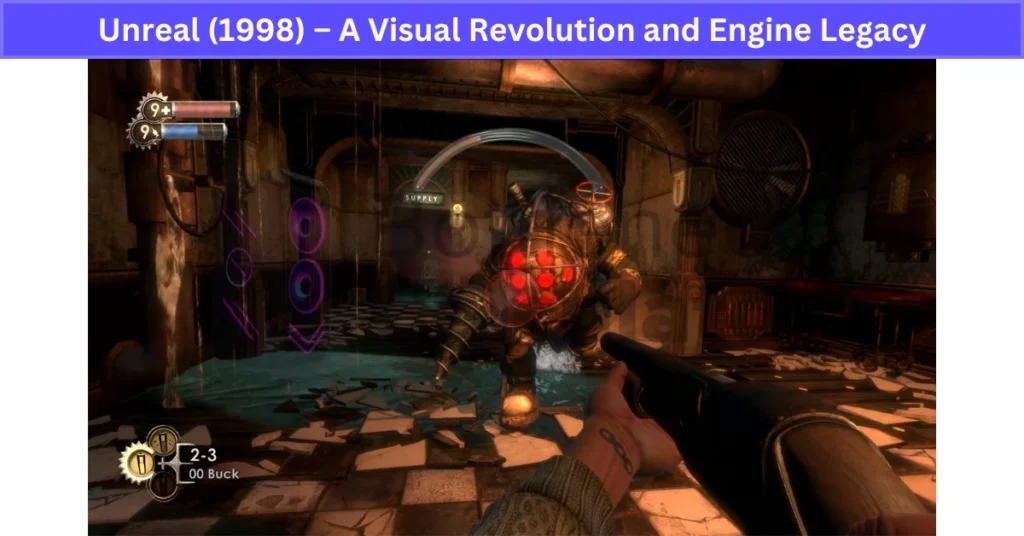
Players and critics loved Unreal for its visuals and design. It became one of the best shooters of its time, and with over 1.5 million copies sold in the first year, it was a clear hit. The Unreal Engine itself quickly became a standard tool in the industry, letting other studios push graphics and design further than ever.
Looking back, Unreal wasn’t just a beautiful shooter set on a wild alien world. It set a new bar for FPS visual innovation and left a legacy that’s still shaping games decades later. The influence of Epic MegaGames Unreal legacy is everywhere you look in modern gaming.
Crysis (2007) – The Ultimate PC Benchmark and FPS Powerhouse
I’ve seen Crysis become the gold standard for what a PC could handle. When someone asks, “Can it run Crysis?”—it’s not just a joke. That phrase became a meme because Crysis pushed hardware further than any other game at the time. Released by Crytek in 2007, this FPS set the bar for what cutting-edge graphics could look like, all thanks to CryEngine 2.
Crysis FPS benchmark wasn’t just talk. The game brought in realistic water that sparkled, dynamic lighting that made everything look alive, and environments you could actually break apart. Even today, I see gamers comparing their setups by whether they can max out Crysis. Back then, if you wanted to show off your PC, this was the game you’d use. The PC gaming performance test wasn’t complete unless Crysis was part of it.
But Crysis wasn’t just about pretty graphics. It took FPS gameplay to the next level with its nanosuit gameplay mechanics. You could run fast, punch hard, or turn nearly invisible—all with the tap of a button. On top of that, the open-world sandbox design set on a lush tropical island gave you a lot of freedom. Want to sneak past enemies? Sure. Want to go loud and destroy everything? Also possible. That tactical choice made every run feel different.
The cultural impact of Crysis meme culture is still around. People remember how only the best rigs could play it smoothly at launch. In fact, when it first dropped, even top-end PCs had to work hard to get good frame rates. It really was one of the most demanding games ever made for its time.
Looking back, Crysis set new standards for what shooters could be. The CryEngine 2 graphics, destructible worlds, and freedom of movement all helped shape modern FPS design. It’s more than a tech demo—it’s a legend that forced the whole industry to step up its game and better understand how bottlenecks can affect FPS. For me, Crysis will always be the title that proved how far PC gaming could go, both as a performance showcase and an innovative shooter.
Left 4 Dead (2008) – The Co-op Zombie Shooter That Changed FPS Forever
I’ve seen Left 4 Dead shake up FPS gaming by making teamwork the heart of survival. Released by Valve in 2008, this game took the classic shooter idea and flipped it, turning it into a frantic, social fight against massive zombie hordes.
What made Left 4 Dead co-op FPS stand out was its AI Director dynamic system. This smart tech would change the game every time you played. If your team was doing well, the AI Director would throw more zombies at you. Struggling? It might ease up a bit. No two runs ever felt the same, and that kept the game super fresh.
At its core, Left 4 Dead was all about 4-player co-op survival. You needed to work together, call out dangers, share health kits, and plan your moves. The integrated voice chat and ping features made talking and coordinating with your friends easy—even if things got wild fast. You just couldn’t survive on your own.
Each campaign played out in fast-paced, wave-based combat, and you always had to watch your resources. Ammo and health were limited, so you couldn’t just run and gun the whole way. Enemies didn’t always pop up in the same place, either—procedural enemy placement made sure you had to stay alert every single time.
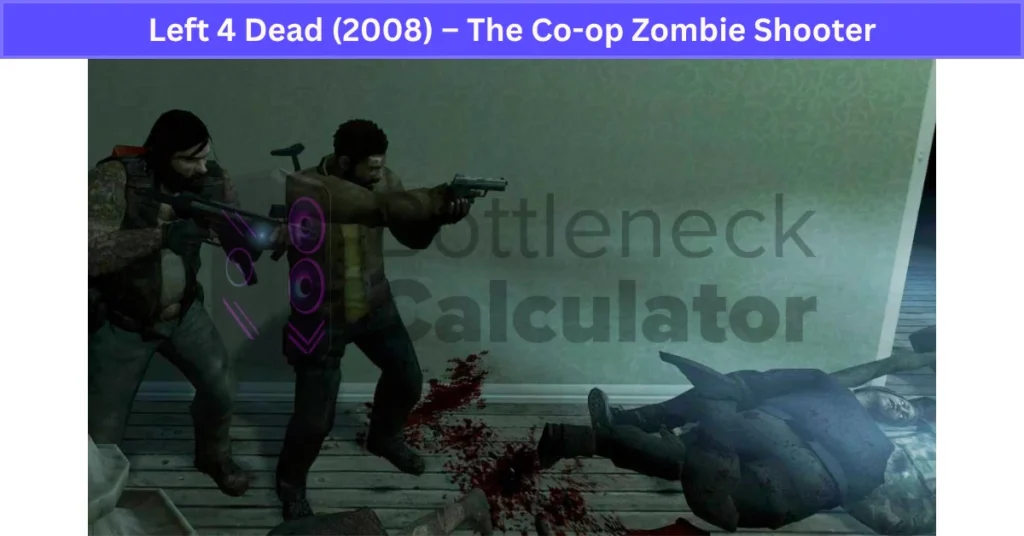
This Valve survival FPS wasn’t just another shooter—it changed how we look at team-based zombie shooter games. Left 4 Dead sold over 3 million copies in its first year and picked up awards for its multiplayer innovation. Its success inspired a whole wave of modern co-op shooters like Back 4 Blood, World War Z, and even influenced how team dynamics work in today’s battle royale games.
Looking back, Left 4 Dead turned FPS into something much more social and unpredictable. It’s the reason so many gamers still talk about their craziest, funniest, or scariest moments from the game. That legacy—shaping the evolution of FPS multiplayer and making cooperation fun and necessary—is what makes Left 4 Dead a true cult classic.
Medal of Honor: Allied Assault (2002) – The Birth of Cinematic War Shooters
I’ve seen Medal of Honor: Allied Assault take FPS games to a new level with its cinematic style and realism. Released in 2002 by 2015, Inc. and published by EA, this WWII FPS set a new standard for what a shooter could be, especially on PC.
The most unforgettable moment? That Normandy beach landing mission. Inspired by Saving Private Ryan, it threw players right into chaos, with bullets flying and explosions everywhere. For a lot of gamers, this Normandy mission FPS felt like stepping into a real war movie. Back then, people called it “the most realistic war sequence in gaming,” and honestly, it still holds up as one of the best in the genre.
Gameplay in Allied Assault was all about immersion and realism. You got to use historically accurate weapons and fight through gritty, war-torn European environments. The missions weren’t easy, either—this wasn’t just running and gunning. Each level demanded smart moves, cover, and teamwork, making the whole experience tough but rewarding. That higher difficulty made every success feel earned and added to the sense of realism.
What really set this game apart was its attention to sound and atmosphere. The authentic sound design—rifles cracking, tanks rumbling, soldiers shouting—made you feel like you were right in the middle of battle. Environmental effects like smoke, weather changes, and crumbling buildings pulled you even deeper into the action.
Medal of Honor Allied Assault history isn’t just about its own success; it kicked off the whole cinematic FPS games trend. Its focus on realistic war settings and big moments inspired future franchises like Call of Duty and Battlefield. Many of the developers who worked on Allied Assault later went on to help create Call of Duty, so you can see the direct link between these classics.
Looking back, Allied Assault didn’t just raise the bar for WWII FPS evolution—it created the blueprint for the modern war shooter. Its mix of tough missions, authentic design, and Hollywood-level intensity made it a classic that’s still remembered today. If you’re into FPS games that make you feel like you’re living the story, this one is a must-play.
Metroid Prime (2002) – Redefining FPS Through Exploration
I’ve seen Metroid Prime completely flip what people expected from an FPS. When it landed on the Nintendo GameCube in 2002, it didn’t just stick to shooting—it made exploring and solving puzzles just as important as blasting enemies.
Metroid Prime GameCube wasn’t your typical shooter. It used a first-person view, but the real magic was in the scan visor. This tool let you scan the world for secrets, clues, and hidden lore. Instead of just fighting everything in sight, you had to slow down, look around, and figure out how to move forward. The game mixed in platforming—jumping between platforms, backtracking with new abilities, and unlocking shortcuts as you learned the alien world.
What really set this game apart was the atmosphere. The environments felt alive, strange, and mysterious. You’d move through seamless level transitions, never seeing a loading screen, just flowing from one area to the next. Every part of the planet was packed with deep lore and cool details, so just looking around felt rewarding.
Metroid Prime’s FPS exploration mechanics made the game feel more like an adventure than a straight-up shooter. It proved that first-person adventure games could be about much more than fast action. The hybrid shooter platformer style inspired tons of other games to blend genres, showing that FPS could be immersive, thoughtful, and even a little bit lonely in a good way.
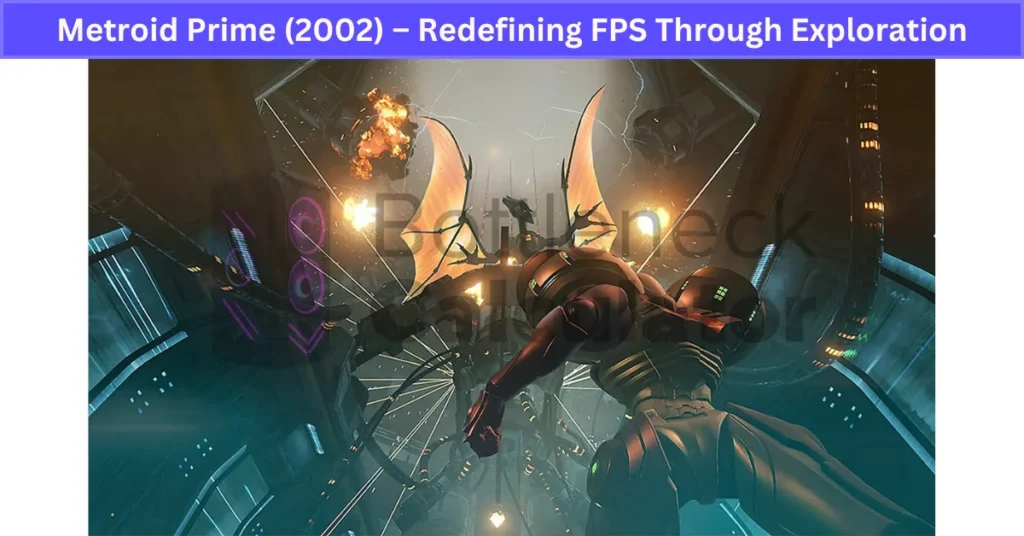
This game wasn’t just popular—it was praised as one of the best of its era by sites like IGN and Nintendo Power. It sold over 2.8 million copies and picked up multiple Game of the Year awards, cementing its place in gaming history.
Looking back, Metroid Prime set the bar for atmospheric first-person gaming. It showed the whole industry that FPS games could have brains as well as firepower—and its influence on hybrid game design is still clear today. If you want a shooter that makes you think and explore, Metroid Prime is the one that started it all.
BioShock (2007) – Storytelling and Philosophy in an FPS
I’ve seen a lot of shooters, but BioShock (2007) stands out for how it changed what people thought an FPS could be. When it launched, everyone was talking about its mix of deep storytelling, wild gameplay, and a world that felt totally unique. BioShock 2007 review scores were through the roof, and for good reason—it proved shooters could be art.
BioShock dropped you into Rapture, an underwater city built with jaw-dropping art deco style. Right away, you could tell this place was different—beautiful but creepy, full of mystery and danger. The atmosphere was thick, with every hallway and broken sign telling a story. The Big Daddy Little Sister pair became instant icons, always leaving you on edge whenever you heard their heavy footsteps.
What really blew me away was the story. BioShock didn’t just have a cool plot; it dug deep into big ideas like objectivism in video games, free will, and the meaning of choice. That “Would You Kindly” twist? Still one of the best moments in gaming history—when I first saw it, my jaw hit the floor. It made me rethink everything I’d done in the game.
Gameplay was just as creative. Sure, you had classic FPS shooting, but the plasmid system BioShock used meant you could mix gunplay with wild powers—shooting lightning, freezing enemies, or sending a swarm of bees after them. Every fight felt fresh because you could combine abilities however you liked. Plus, RPG customization let you shape your own play style, adding another layer of depth.
BioShock wasn’t just a great game—it was a masterpiece. Critics loved it, with Game of the Year awards piling up in 2007, and it sold over 4 million copies in its first two years. Its hybrid gameplay and focus on narrative changed the way other games were made, pushing developers to think bigger and bolder.
Looking back, BioShock is the reason people now talk about FPS with storytelling and artistic style in the same breath. Its legacy lives on in every narrative-driven shooter and hybrid game you see today. For me, it’s one of the greatest FPS games of all time—a game that actually made me think while I played.
Call of Duty 4: Modern Warfare (2007) – The FPS That Defined a Generation
I’ve seen a lot of shooters come and go, but Call of Duty 4: Modern Warfare changed everything for me—and for the whole FPS world. When it dropped in 2007, it was like a shockwave. Suddenly, everyone wanted modern settings, cinematic action, and multiplayer that hooked you for months. It’s not just an iconic FPS game; it’s the title that set the new rules.
Call of Duty 4 Modern Warfare history started with a bold move. After years of WWII battles, Infinity Ward jumped into modern combat—urban firefights, high-tech gear, and a gritty, real-world tone. This shift felt so fresh, giving the whole genre a new style and attitude. The modern warfare campaign wasn’t just a series of missions; it played like a blockbuster movie. Scripted set pieces, fast pacing, and unforgettable moments made every level stand out. The “All Ghillied Up” mission is still one of the most talked-about missions ever. Crawling through the grass, holding your breath, and trying not to get spotted—that memory sticks with you.
But what really set Modern Warfare apart was the multiplayer. I remember my first time unlocking a new weapon or calling in a killstreak—there was nothing like it. COD multiplayer innovation meant a full progression system, where you leveled up, unlocked perks, and built your own loadouts. That sense of reward kept me and millions of others coming back night after night. Killstreak rewards like UAVs and airstrikes added a whole new tactical layer, making every game feel different. The system became the new standard for almost every FPS that followed.
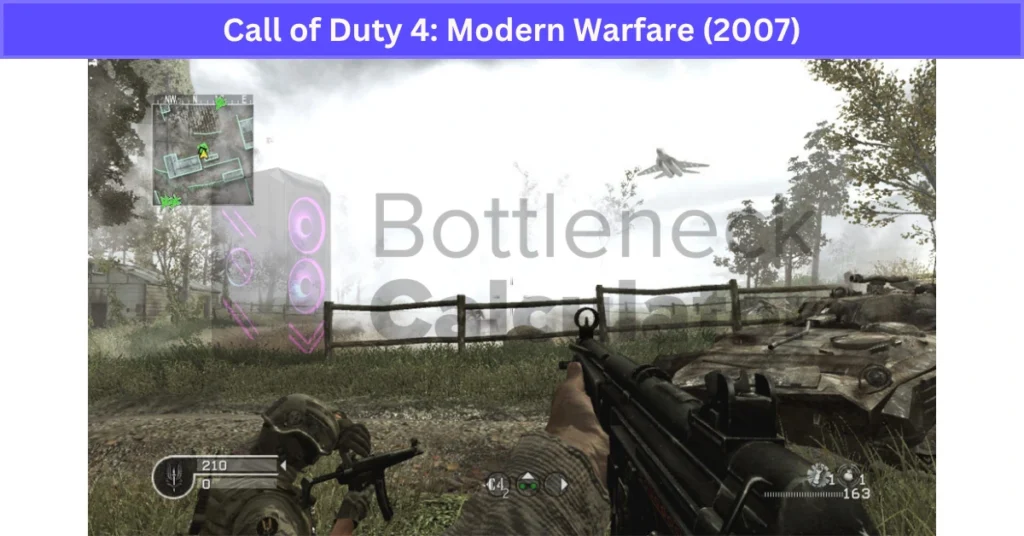
Modern Warfare didn’t just change how games played; it changed how people played together. It pushed online competitive gaming into the mainstream, inspired massive tournaments, and helped shape eSports as we know it. The influence spread everywhere—future COD games, Battlefield, and pretty much every shooter since has borrowed something from Modern Warfare’s playbook.
This game’s impact was huge. Modern Warfare sold over 16 million copies by 2009, won multiple Game of the Year awards, and set a new benchmark for the industry. The multiplayer progression, the cinematic campaign, the unforgettable missions—all of it made COD4 a legend.
Honestly, if you ask me, Modern Warfare is the FPS that defined a whole generation of gamers and developers. Its legacy is everywhere in shooters today, and I still remember how it made me feel the first time I picked up the controller. That’s the mark of a true genre benchmark.
Overwatch (2016) – The Hero Shooter That Changed Team Play
I’ve seen Overwatch totally shake up the FPS world by blending classic shooter action with hero-based strategy. Released by Blizzard Entertainment in 2016, Overwatch hero shooter became the first big hit to truly mix shooter gameplay with the unique abilities you’d expect from a MOBA. It wasn’t just about who could aim best—it was about building a great team and playing your part.
The magic of Overwatch was its lineup of diverse heroes, each with their own powers and playstyle. You had tanks soaking up damage, healers keeping the squad alive, and damage dealers doing the flashy plays. The team-based FPS innovation was clear: your squad had to work together, thinking about team comp and synergy instead of just who got the most kills. That shift from solo fragging to real team tactics made every match feel fresh and competitive.
Overwatch also ditched the old-school deathmatch focus and put everyone’s eyes on objectives. Winning meant pushing payloads, holding points, or pulling off last-second saves with perfectly timed ultimate abilities. The game made me think more about strategy and less about just running and gunning. And because every hero felt so different, learning team-based combos and finding your favorite playstyle kept things exciting.
When it came to esports, Overwatch League esports was a game-changer. Blizzard put big money into making competitive Overwatch a real global event, with city-based teams and huge audiences. Suddenly, pro FPS had a new face—bright, colorful, and full of wild plays and nail-biting finishes. The Overwatch League set a new bar for structured competition and brought a ton of attention to hero-based game design.
Culturally, Overwatch had a massive footprint. Its vibrant art, inclusive character lineup, and easy-to-learn mechanics helped it reach over 50 million players by 2019. It won Game of the Year in 2016 and kept inspiring other games like Apex Legends and Valorant to follow the hero shooter trend. You could see cosplay, fan art, and memes everywhere, showing how deep Overwatch went into gaming culture.
Looking back, Overwatch stands as the pioneer in the hero shooter era. It proved FPS games could be fun, strategic, and about more than just shooting. Its blend of teamwork, unique heroes, and competitive spirit changed what I thought shooters could be—and its influence on competitive FPS trends and esports is still huge today.
How FPS Graphics and Engine Technology Leveled Up
I’ve seen FPS games go from blocky, simple shooters to insanely lifelike worlds—and it all comes down to graphics and engine tech getting better every year. At first, shooters looked pretty rough, but with each new engine, things just kept getting more real and more exciting.
Back in the early days, games like Wolfenstein 3D used basic 2D sprites to fake a 3D look. Then came Doom and Quake, and suddenly, real-time lighting, textured walls, and 3D models made everything pop. Quake especially was a game-changer—being the first fully 3D FPS, it let players look and move any way they wanted. That was huge for FPS graphics innovation.
By the time we got to Unreal and Half-Life, engines started to focus on atmospheric effects and smooth physics. Games could create weather, moving water, and even facial expressions that looked kind of believable. Unreal Engine’s debut in 1998 pushed things further, making lighting and reflections stand out. These engines didn’t just power one game—they became tools that everyone in the industry started using.
Then Crysis dropped in 2007 with CryEngine 2, and suddenly, everyone was asking, “Can it run Crysis?” The game set a new bar for realistic water, shadows, and destructible worlds. Hardware companies used it to show off their graphics cards because the visuals were so advanced.
Now, we’ve got engines like Unreal Engine 5 that do photorealistic environments, ray tracing, and physics so real you sometimes forget you’re playing a game. FPS games drive this tech—every time a new shooter pushes graphics further, the whole industry follows, especially when optimizing for setups like a multi-monitor setup.
Honestly, every leap in FPS engine technology has made games more immersive and believable. It’s why when you jump into a new shooter today, you almost feel like you’re in another world. That drive for better visuals and smoother play is a big reason why FPS games keep leading the pack.
How FPS Games Shaped Modern Game Mechanics
I’ve seen first-person shooters do more than just start trends—they totally rewrote the rules for how games are played. A lot of the stuff we see in games today started with classic FPS titles and just stuck because it worked so well.
For one, FPS games made aiming and shooting a real skill. Before shooters took off, most games were about jumping or timing. Now, if you want to be good, you’ve got to practice your aim, learn weapon recoil, and get smart with cover and movement. Mechanics like aiming down sights, quick-scoping, and even sprinting between cover all came from FPS roots.
Team-based gameplay is another big one. Games like Counter-Strike and Overwatch put huge focus on squad tactics and class abilities. Instead of just playing solo, you have to work with your team, balance roles, and communicate to win. Those mechanics now show up in battle royales, hero shooters, and even in some RPGs.
FPS games also introduced things like killstreaks and unlockable perks—COD’s multiplayer progression system changed the whole industry. Suddenly, you’re not just playing for fun, but for new gear, cosmetics, and that next big unlock. Even non-shooter games copied this formula because it kept players coming back.
Let’s not forget how FPS games made health systems smarter. Regenerating health (think Halo) and realistic damage changed how players approached fights. It wasn’t just about picking up health packs—sometimes you had to play smart and back off to heal, adding a layer of strategy.
And finally, FPS titles brought new ways to tell stories. Games like Half-Life and BioShock used the first-person view to put you right in the story, making everything more personal and immersive. Environmental clues, voice logs, and story moments happening as you play all started here.
Honestly, if you look at modern games—action, RPG, even sports—you’ll see fingerprints of FPS game mechanics everywhere. They’re the reason games feel fast, skill-based, and rewarding now. That’s how big the FPS influence has been.
Key Innovations of Influential FPS Games
I’ve seen a lot of games try to shake things up, but FPS game innovations have really set the pace for the whole industry. These shooters didn’t just make combat more exciting—they changed how we play with others, told deeper stories, and made game worlds more immersive. The most iconic FPS mechanics still show up in new games today, shaping what people expect from a great shooter.
Advancements in Multiplayer Design
Some of the biggest jumps in multiplayer FPS design started with classic games. Doom (1993) brought in the deathmatch mode, letting players battle each other instead of just fighting AI. This laid the foundation for all competitive gaming that followed.
Quake (1996) took things further with a true client-server model, which meant online play was smoother and more reliable. It made playing against people all over the world a real possibility, not just a laggy dream.
Halo: Combat Evolved shook up consoles by making LAN multiplayer easy and fun. It also added vehicles, making battles feel bigger and more dynamic. Before Halo, most people thought shooters were just for PC, but this one proved consoles could do it too.
Counter-Strike raised the bar with team-based objectives and an in-game economy system. Instead of everyone just running around for kills, you had to plan, work with your squad, and manage your money. This Counter-Strike team-based gameplay style changed how shooters could be played—and how competitive they could get.
Impactful Narrative Storytelling
The evolution of environmental storytelling in shooters has been just as huge. Half-Life (1998) ditched cutscenes and let the story happen around you, keeping you in control and in the world the whole time. It made the game feel real and the stakes personal.
BioShock (2007) took it to another level with deep environmental storytelling and audio logs scattered through the world. Every corner of Rapture told a piece of the story, and you picked up the bigger picture by exploring.
The Call of Duty series became known for cinematic missions and switching perspectives between different soldiers. That approach gave players a sense of scale and realism, making war stories hit a lot harder.
Portal was clever too, blending story and puzzles together. The character GLaDOS turned the game into a narrative experience, not just a test of logic.
If you put these innovations side by side, you see why they matter:
| Innovation | Game | Year |
|---|---|---|
| Deathmatch Multiplayer | Doom | 1993 |
| Client-Server Online Play | Quake | 1996 |
| Team Economy & Objectives | Counter-Strike | 1999 |
| Cinematic Story Integration | Half-Life | 1998 |
| Audio Logs & World Story | BioShock | 2007 |
All of these FPS game innovations are the reason shooters like Apex Legends, Valorant, and Destiny 2 feel as good as they do now. The best ideas just keep coming back—and that’s what keeps the genre moving forward.
Cultural and Industry Impact of FPS Games
I’ve seen first-person shooters do way more than just entertain—they’ve actually shaped how we connect online, compete, and even drive tech forward. The FPS impact on technology and culture goes far beyond game consoles and PCs. These games have changed what it means to play together, built massive communities, and pushed hardware makers to keep improving.
Shaping Esports and Online Communities
It’s wild to think about, but FPS games started the whole esports history FPS story. Back in 1997, Quake was at the heart of the first major esports event, Red Annihilation. The winner didn’t just get bragging rights—they got John Carmack’s Ferrari! That’s how serious things got even in the early days.
Then you’ve got Counter-Strike, which started as a simple Half-Life mod and became a true global esports staple. Now, there are pro leagues, packed stadiums, and multi-million-dollar prize pools. If you ever watched a CS:GO final, you know the hype is real.
FPS clan systems were also ahead of their time. These early online squads helped lay the groundwork for platforms like Discord and Twitch, where today’s communities gather, stream, and chat about their favorite games. The idea of online FPS community growth started with gamers forming groups and organizing matches, and it just took off from there.
Driving Technological Progress
The “Doom effect” in the ’90s was no joke. When Doom launched, people literally upgraded their computers just to play it. That trend continued—every new FPS pushed hardware makers to deliver faster, better graphics. Nvidia and AMD have always loved to use FPS games to show off their latest GPUs, knowing gamers would chase the best visuals and smoothest framerates.
It wasn’t just about graphics, though. FPS developers pushed motion capture to a new level to make movement feel real—tech that’s now standard in blockbuster movies and even medical research. The focus on realism in FPS games helped push this tech mainstream.
The VR FPS evolution is another leap. When games like Half-Life: Alyx hit, they showed just how immersive virtual reality could be. Suddenly, VR wasn’t just a cool demo—it was a real gaming platform, and investment poured in. Now everyone is chasing that next step in interactive experiences.
FPS games played a huge role in all of this. In 2023 alone, FPS esports generated a major chunk of the $1.5 billion global esports market. These titles aren’t just shaping gaming, they’re driving how tech evolves everywhere by setting new standards in gaming performance metrics.
Looking forward, I’d bet FPS games will help lead the way as new tech comes in, from AR glasses to AI-driven worlds. The innovation that started with Doom and Quake is still pushing things forward. If history’s any clue, the next big leap in entertainment and tech might just come from the FPS genre again.
How FPS Games Changed the Way We Play
I’ve seen first-person shooters completely change what it feels like to play a game. Before FPS games came along, most titles were 2D or third-person—fun, but you always watched the action from a distance. Once FPS games started letting us see the world through the character’s eyes, everything about gaming felt way more personal and real. Suddenly, you weren’t just controlling a hero; you were the hero.
Immersion Through First-Person Perspective
The biggest game-changer for me was first-person perspective immersion. Instead of looking at your character from above or behind, you looked out through their eyes. That single shift made every world feel bigger, scarier, and more alive. You’d flinch when bullets zipped past or feel your heart pound sneaking through a dark hallway. Compared to older 2D or side-scrollers, FPS games just sucked you in—emotionally and visually.
Interactivity and Realism
FPS realism mechanics pushed things even further. Suddenly, aiming down sights wasn’t just a cool trick—it was the standard. Games started using realistic recoil, weapon handling, and reload animations that made shooting feel authentic. Developers piled on advanced graphics and physics, from ragdoll effects to destructible environments. The more real things looked and felt, the more you got lost in the game. Watching an enemy’s body react naturally or a wall crumble after a grenade—those little touches added up and changed how we expect games to play.
Social Connectivity and Competitive Play
FPS games also kicked off a whole new wave of social gaming communities. I remember the days of LAN parties—gathering with friends, connecting PCs, and staying up all night. As online multiplayer FPS evolution took over, those games turned into giant social spaces. Counter-Strike started as a mod, but it grew into its own world with clans, voice chat, and streaming. Competitive FPS gaming exploded into full-blown esports, and now games like COD, CS:GO, and Valorant make up a huge chunk of global multiplayer playtime. FPS isn’t just about solo action; it’s about connecting with others and building your own crew.
All together, these elements made FPS games the heart of modern gaming. The immersion, realism, and social connection are why first-person shooters keep leading the way, shaping what players expect from their gaming experiences today.
Real User Fixes & Community-Backed Solutions
Quora
We found a user on a community forum asking about the most important games throughout FPS (first-person shooter) history. The discussion highlighted classics like Wolfenstein 3D and Doom as foundational titles that popularized the genre with 3D environments and immersive gameplay. Other key mentions included Quake, Unreal Tournament for multiplayer innovation, and Counter-Strike for competitive realism.
Community members also noted earlier influences like Maze War and Battlezone, and praised games such as Rainbow Six and Halo for evolving the tactical and narrative aspects of FPS gaming. Overall, the consensus is that FPS games evolved through breakthroughs in graphics, multiplayer, and realism, shaping the gaming landscape we know today.
On r/gaming, a user asked about the top 5 most influential FPS games of all time. Popular answers included Doom, Half-Life, Halo: Combat Evolved, Quake, and GoldenEye, with many praising Doom for pioneering fast-paced gameplay and modding, and Half-Life for advancing storytelling in shooters.
Community members also highlighted Counter-Strike for competitive multiplayer, Unreal Tournament for refining online PvP, and Call of Duty for its modern impact. Overall, the discussion reflects how these titles shaped FPS gaming through innovation in gameplay, multiplayer, and narrative.
Final Verdict
First-person shooter games didn’t just change gaming—they set the standard for how we play today. From the early days of Wolfenstein 3D and Doom to modern giants like Call of Duty and Valorant, FPS games pushed technology, made multiplayer huge, and even helped kick off esports. They turned gaming into something social, competitive, and immersive.
In short, FPS games are the reason gaming is as big and exciting as it is now. Their impact goes way beyond just shooting—it’s about community, innovation, and the way we experience virtual worlds.
FAQ’s
What is the most important FPS game?
Doom is often called the most important first-person shooter game ever made.
What game changed the gaming industry?
Back in 1989, Nintendo released the Game Boy with just one game—Tetris. That combo changed everything for handheld gaming. Tetris made the Game Boy a must-have, showing everyone that playing games on the go could be huge. With more than 35 million copies sold, Tetris on Game Boy didn’t just start a trend—it made portable gaming essential for millions.
What FPS game was introduced in 1993 that helped create the gaming industry?
Doom launched on December 10, 1993, and completely changed the gaming scene by turning first-person shooters into a huge part of mainstream entertainment. Its intense action and groundbreaking 3D visuals set a fresh standard for FPS games, opening the door for future hits and helping the gaming industry grow into a global powerhouse.

